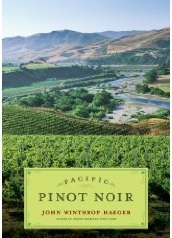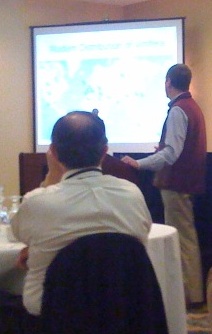Why Pinot?

John Winthrop Haeger reigns supreme in the world of North American Pinot Noir publishing. His latest from last year, "Pacific Pinot Noir: A Comprehensive Winery Guide for Consumers and Connoisseurs", along withhis earlier work, "North American Pinot Noir", have made him the very largest of fishes in a very small pond of authors investigating the world of Pinot Noir on the North American contitnent.
I've always contented its easier on the soul and the ego to be a big fish in a little pond than a big fish in a big pond. Fewer sharks.
So, it's no surprise that Haeger would open the World of Pinot Noir with a talk to the members of industry, trade and consumer set that dragged themselves downstairs at the Cliffs Hotel at 8:30am to kick off a few days of Pinot indulging.
Haeger's topic: "The Origins of UNsustainable Viticulture and Where Pinot Noir Is Grown Now".
I've often pondered the virtues of different sorts of titles for talks. You can take the "Haeger Approach" and
go for "explicit directness". Or you can take the indirect approach. That would look something like: "Pinot Noir: The Viticultural Screw Up Factor."
Either way, it is not surprising that Haeger's talk would be primarily a history lesson (beginning with talk of viticultural projects dating to 10,000 BC). Haeger is a trained historian, specializing in Chinese history and language. Not so much any more. Today Haeger is a terrific presenter of wine information.
Haeger ran through 12,000 years of vinticultural history in about 40 minutes, ending by placing special emphasis on the Pinot Noir grape. His talk was fascinating. But most interesting of all was the observation that for the past 40 years, the number of acres under vine world wide has been decreasing. Yet, Pinot vines and pinot production have both been increasing.
Why Pinot? That's what I'm wondering?
I suppose there is a good reason or a set of reason that tell exactly why Pinot Noir has increased its acreage while other, better known varieties have not. But I don't know what that set of reasons is. But I have some theories;
1. Pinot, given its modest body, is easy to drink. The explosion of new wine drinkers want "easy to drink."
2. Pinot is a "Prestige" wine. A great deal of the new Pinot vineyards have cropped up in areas that are relatively new to winemaking and there is a desire to make a mark on the winemaking world.
3. It started from a relatively small amount of plantings to begin with.
Too simple?

“To simple?”
Too simple.
Way too simple.
I don’t think that those theories are “too simple”. A lot of things are simple or at least elegant (the way physicists mean; not the way wine tasters mean). Those three reasons could easily be contributing factors to the increasing acreage of pinot.
I think Freestone winemaker Heredia approached some interesting material with regard to vinification with the modern clones of pinot noir, in the recent article in the northcoast paper, namely, with pinot the flavors and aromas are better balanced when alcohol content is closer to the traditional French 12.5 than the typical racy contemporary CA 14, although Freestone seems to have accomplished some blending artistry with the current early wines from their Sonoma Coast AVA acreage, all registering in the hot range on alcohol content. Of course, a different view of the topic she was addressing likely is the heat summation which yields low sugar, the yeast’s source for alcohol content in the final product.
Playing catch up on my reading here. 12,000 years of vinicultural history does sound interesting, especially when you say he did it right. Is there a podcast or youtube video of the discussion online?